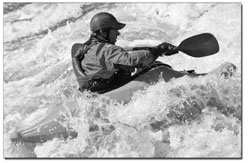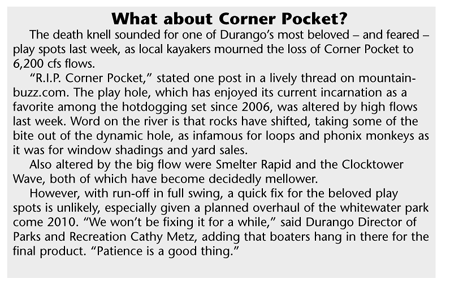| ||||||
| Taming high water New Durango Boating Park looks toward 2010 SideStory: Animas River Days goes big
by Missy Votel With high water hitting Durango, the future of the town’s whitewater park is also high on the minds of local boaters. However, those anxious for the next phase of the play park’s evolution may have to hold their breath for at least one more season. “There’s no money for the whitewater park in this year’s budget,” said Durango Director of Parks and Recreation Cathy Metz, “but, we are starting the process of moving forward on the design and implementation of the new park.” Metz said she estimates that money for the design of the 850-foot whitewater park at Santa Rita Park, which will include 11 total features, including four riverwide ones, will be in the 2009 budget. Construction costs will likely be allocated in the 2010 budget. “If everything goes as planned, we hope to start building in 2010,” she said. Metz said construction of the features likely won’t happen any sooner because in addition to the public process on design, the city will also need to secure a new 404 Permit from the Army Corps of Engineers in order to do the work. The city currently operates under a temporary permit from the Corps, which allows for minor upkeep on a periodic basis. Funds for the design and construction of the park were not requested for 2008 because at the time budget requests went in, the city was embroiled in a lawsuit over its request for recreational water rights, also known as a recreational in-channel diversion or RICD. However, the City of Durango as well as La Plata County and the Southwest Water
Conservancy District, representing some 50 upstream water users, settled out of court last November. The settlement, which negated a January 2008 court battle, granted the city its requested flow. Depending on the season, between 185 and 1,400 cubic feet per second will flow through the 1,000-foot stretch of the Animas River at Santa Rita Park. The agreement, which was lauded by all sides, ended a three-year dispute that started in 2006 when the city first applied for the RICD. However, as per legislation forwarded by Durango’s own Sen. Jim Isgar, D-Hesperus, all RICDs in the state require a permanent structure to catch and direct the flow. As a result, the city is taking steps to design and build a play park that will utilize permanent river features using stockpiled boulders and possibly grout, which has been a contentious subject in the past. In addition to meeting the criteria of the RICD, the permanent structures will also help keep the play park’s features in place during high water, which has been an ongoing problem for boaters and the city over the years. In 2006, the city held a public meeting with former Olympic paddler Scott Shipley, of Boulder-based Recreation Engineering. The firm, founded by whitewater park pioneer Gary Lacy, who is responsible for play parks in Salida and Steamboat, among others, has worked with the city on and off over the last several years. However, Shipley has since gained his engineering license and struck out on his own with S2O Designs, which Metz said the city will most likely use in the planning stages. Shipley is most notable for his work on the whitewater facility in Charlotte, N.C., which operates on a pump system. “We’ve hired Scott Shipley, and although we haven’t been in touch with him lately, we have talked to him about getting the 404 process going,” she said. Metz estimates spending about $75,000 in 2009 on design, legal fees and consulting. During preliminary whitewater park planning in 2006, the costs of the park’s construction was estimated at $550,000 she said. Although it will likely be higher, many municipalities, such as Glenwood Springs, have tapped into Great Outdoors Colorado lottery funds to help offset the costs. The Durango plan, which was unveiled at a public meeting in 2006, was the culmination of three years of work by the Animas River Task Force. A consortium of river users and interest groups, the task force was formed in 2003 to help guide the whitewater park’s planning process. “The Animas River Task Force looked at that latest plan carefully in 2006,” said Metz. “And I’m sure as we get back into the planning process, we’ll look carefully at those plans again.”
|




